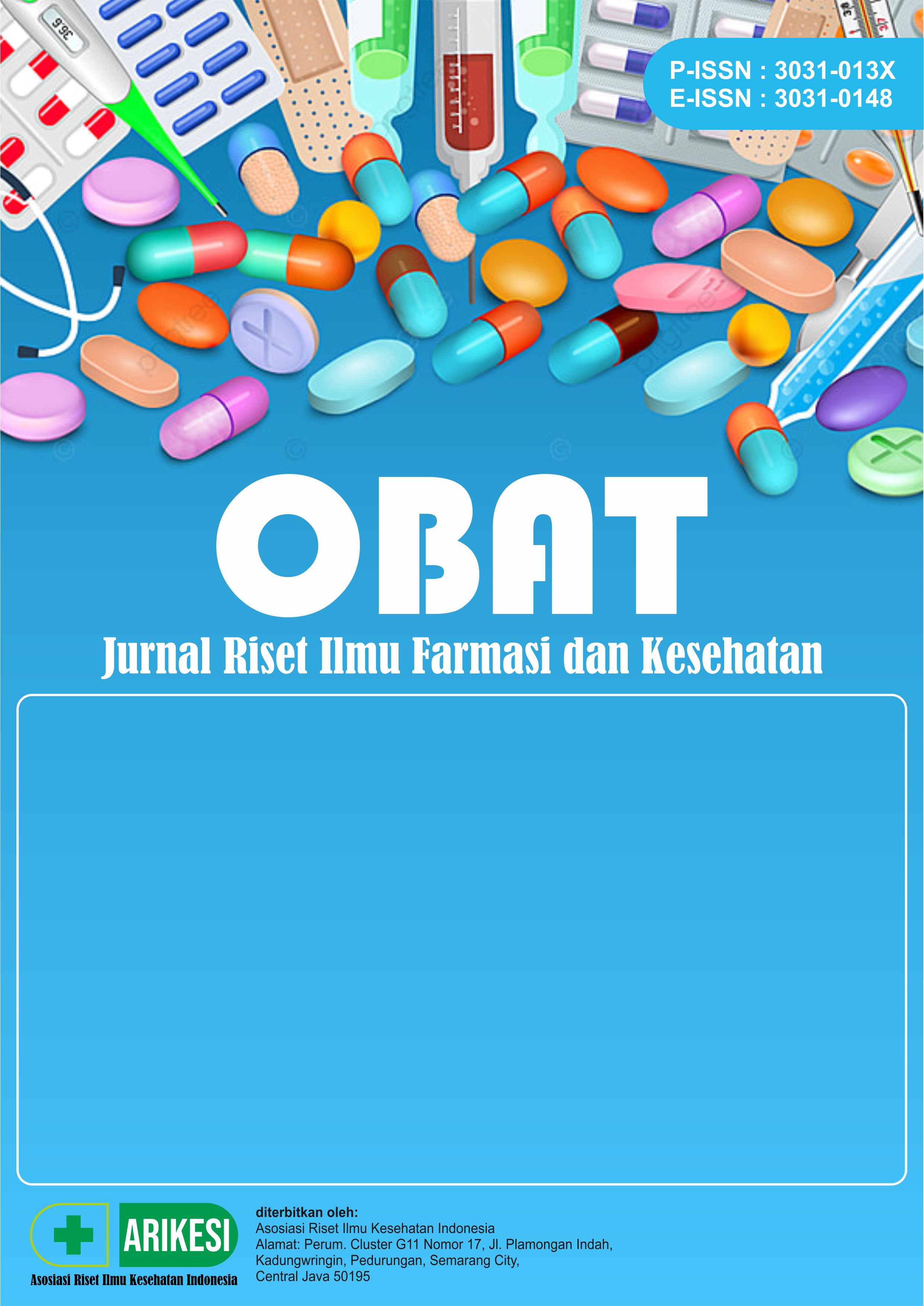Studi Stabilitas Sediaan Suspensi Obat dalam Kondisi Suhu yang Berbeda
DOI:
https://doi.org/10.61132/obat.v3i4.1557Keywords:
Stability test, pharmaceutical preparations, suspensionsAbstract
Stability testing is an important step in the development of pharmaceutical products. This testing must be conducted before the product is manufactured, whether on an industrial or non-industrial scale. Currently, liquid formulations are experiencing rapid development, one of which is suspension. Suspension itself is a liquid formulation that contains undissolved solid particles dispersed in the liquid phase. To assess the stability of suspension, various evaluations are performed such as organoleptic tests, sedimentation volume, redispersion, density, viscosity, particle size distribution, and pH measurement. Based on several studies, temperature is known to affect the stability of drugs, especially in suspension formulations. A study related to diclofenac suspension showed that at a temperature of 4°C, its stability reaches 96.3%, while at temperatures of 40°C and 60°C, there is a significant reduction in content, amounting to 89.58% and 85.17% respectively. Meanwhile, research on folic acid suspension revealed that the drug remains stable at temperatures of 4°C and 25°C, although on day 90 there was an increase in pH. Another study on cefuroxime axetil suspension showed that at a temperature of 20°C, its concentration was 87.68%, while at 5°C, it was higher at 92.35%. This research underscores the importance of considering temperature in the storage and formulation of pharmaceutical suspensions to maintain their effectiveness and stability.
Downloads
References
Abrar, A. N. (2008). Kebijakan komunikasi: Konsep, hakekat dan praktek. Yogyakarta: Gaya Media.
Amaliah, G. A., & Maulana, F. R. (2025). Fenomena campur kode dalam tuturan anak usia sekolah dasar: Kajian sosiolinguistik di SDN Daan Mogot 3. Jurnal Genre (Bahasa, Sastra, dan Pembelajarannya), 7(1), 45–62. https://doi.org/10.26555/jg.v7i1.12388
Damanik, D., & Angelika, F. C. (2021). Pengaruh keterampilan terhadap peningkatan kinerja pastry cook di Departemen Pastry Sheraton Bandung Hotel & Towers. Jurnal Sains Terapan Pariwisata, 1(1). https://journal.polteksahid.ac.id/index.php/jstp/article/view/24
Deviarny, C., Luscida, H., & Safni. (2012). Uji stabilitas askorbil kimia fosfat natrium dalam mikroemulsi dan analisisnya dengan HPLC. Jurnal Farmasi Andalas, 1.
Emilia, E. (2014). Formulasi dan evaluasi stabilitas fisik suspensi ibuprofen dengan menggunakan natrosol HBR sebagai bahan pensuspensi [Disertasi, Universitas Tanjungpura].
Fatmawati, U. (2018). Formulasi suspensi analgesik-antipiretik ibuprofen dengan suspending agent gom arab dan CMC-Na. Journal of Pharmaceutical Care Anwar Medika (J-PhAM), 1(1), 12–15.
Gokani, R., Desai, N., Kinjal, R., & Rina, H. (2012). Stability study: Regulatory requirement. Journal of International Advances in Pharmaceutical Analysis, 2(3), 62–67.
Gozali, D. (2016). Pengaruh suhu terhadap stabilitas obat sediaan suspensi. Farmaka, 14(2), 145–150.
Gunasekaran, G. H., Jusoh, N. H., & Saridin, N. (2015). The stability of folic acid suspension. International Journal of Scientific and Research Publications, 5(8).
Kusumowati, I. T. D. (2011). Uji stabilitas fisik dan daya antibakteri suspensi eritromisin dengan suspending agent Pulvis Gummi Arabici. Pharmacon: Jurnal Farmasi Indonesia, 12(2), 44–49.
Nazir, S. R., Ali, U., Irfan, H. N., Misbah, S., Sajid, B., & Syed, S. H. (2011). Development of diclofenac suspension and its stability study at different temperatures. Pakistan Journal of Pharmacy, 24(1–2), 23–27.
Oktami, E., Lestari, F., & Aprilia, H. (2021). Studi literatur uji stabilitas sediaan farmasi bahan alam. Karya Ilmiah Unisba, 72–77.
Peace, N., Olobukola, O., & Moshood, A. (2012). Stability of reconstituted amoxicillin clavulanate potassium under simulated in-home storage condition. Journal of Applied Pharmaceutical Science, 2(1), 28–31.
Salman, S., Nanda, A. Y. D., Irawan, D. A. H., Wahyudi, N. Y., & Megrina, N. O. E. (2023). Perkembangan uji stabilitas berdasarkan parameter pada sediaan suspensi dengan berbagai bahan aktif yang berbeda. Journal of Pharmaceutical and Sciences, 633–639.
Saputro, M. R., Wardhana, Y. W., & Wathoni, N. (2021). Stabilitas hidrogel dalam penghantaran obat. Majalah Farmasetika, 6(5), 421–435.
Singh, V. J., Mishra, V. K., & Maurya, J. K. (2014). Evaluation formulation of and early stage protein therapeutics cephalexin monohydrate reconstitutional oral suspension with piperine and their antibacterial activity. World Journal of Pharmaceutical Research, 3(5), 821–831.
Uzunović, A., & Vranić, E. (2008). Stability of cefuroxime axetil oral suspension at different temperature storage conditions. Bosnian Journal of Basic Medical Sciences, 8(1), 93–97.
Waney, R., & Abidjulus, J. (2012). Pengaruh suhu terhadap stabilitas serta penetapan kadar tablet furosemida menggunakan spektrofotometer UV-Vis. Pharmacon, 1(2).
Wijaya, H., & Rifda, L. (2021). Formulasi dan evaluasi fisik sediaan suspensi kombinasi ekstrak biji pepaya (Carica papaya L.) dan umbi rumput teki (Cyperus rotundus L.) dengan variasi konsentrasi suspending agent PGA (Pulvis Gummi Arabici) dan CMC-Na (Carboxymethylcellulosum Natrium). Cendekia Journal of Pharmacy, 5(2).
Zaini, A. N., & Gozali, D. (2016). Pengaruh suhu terhadap stabilitas obat sediaan suspensi. Farmaka, 14(2), 1–2.
Downloads
Published
How to Cite
Issue
Section
License
Copyright (c) 2025 OBAT: Jurnal Riset Ilmu Farmasi dan Kesehatan

This work is licensed under a Creative Commons Attribution-ShareAlike 4.0 International License.





